Climate Change Trends and Impacts on California Agriculture: A Detailed Review
Abstract
1. Introduction
2. Method
3. Climate Change Trends in California
3.1. Overview
3.2. Temperature
3.3. Precipitation
3.4. Snowpack
3.5. Extreme Climate Events
3.5.1. Extreme Heat Events
3.5.2. Drought
3.5.3. Streamflow and Flooding
4. Climate Change Impact on California Agriculture
4.1. Crop Climate Relationship and Yield Impacts
4.2. Impacts on Chill Hours
4.3. Impacts on Plants, Pesst, and Diseases
4.4. California Agricultural Vulnerability to Climate Risks
5. Important Findings and Directions for Future Research and Implementation
5.1. Climate Change Is Intensifying Challenges for the Agriculture Sector in California
5.2. Need for Localized Agricultural Adaptation Research to Minimize the Risks Due to Increased Temperatures and Extreme Heat Waves
5.3. Increased Research Efforts on Expanding Adaptation to Water Shortages in Agriculture
5.4. Stakeholder Engagement and Extending Knowledge
6. Conclusions
Acknowledgments
Author Contributions
Conflicts of Interest
References
- CDFA (California Department of Food and Agriculture). California Agricultural Statistics Review 2015–2016. Available online: https://www.cdfa.ca.gov/statistics/PDFs/2016Report.pdf (accessed on 16 June 2017).
- Johnson, R.; Cody, B.A. California Agricultural Production and Irrigated Water Use. Congressional Research Service Report, (R44093), 2015. Available online: http://aquadoc.typepad.com-/files/crs_ca_ag_production_30june2015.pdf (accessed on 29 June 2017).
- Tanaka, S.K.; Zhu, T.; Lund, J.R.; Howitt, R.E.; Jenkins, M.W.; Pulido, M.A.; Tauber, M.; Ritzema, R.S.; Ferreira, I.C. Climate warming and water management adaptation for California. Clim. Chang. 2006, 76, 361–387. [Google Scholar] [CrossRef]
- Natural Resources Agency. Safeguarding California: Reducing Climate Risk an Update to the 2009 California Climate Adaptation Strategy. Available online: http://resources.ca.gov/docs/climate/-Final_Safeguarding_CA_Plan_July_31_2014.pdf (accessed on 30 June 2017).
- IPCC (Intergovernmental Panel on Climate Change). Climate Change 2007: Synthesis Report. Contribution of Working Groups I, II and III to the Fourth Assessment Report of the Intergovernmental Panel on Climate Change; Intergovernmental Panel on Climate Change: Geneva, Switzerland, 2007; p. 104. [Google Scholar]
- Rasul, G.; Chaudhry, Q.Z.; Mahmood, A.; Hyder, W. Effect of temperature rise on crop growth and productivity. Pak. J. Meteorol. 2011, 8, 53–62. [Google Scholar]
- GISS (Goddard Institute for Space Studies) Surface Temperature Analysis. Available online: http://data.giss.nasa.gov/gistemp/graphs/ (accessed on 29 June 2017).
- Hydroclimate Report Water Year 2015; DWR (California Department of Water Resources): Sacramento, CA, USA, 2015.
- Hansen, J.; Ruedy, R.; Sato, M.; Lo, K. Global surface temperature change. Rev. Geophys. 2010, 48. [Google Scholar] [CrossRef]
- WRCC (Western Regional Climate Center). California Climate Tracker. Western Regional Climate Center. Available online: http://www.wrcc.dri.edu/monitor/cal-mon/index.html (accessed on 20 July 2017).
- Ladochy, S.; Ramirez, P.; Killam, D.; Bui, A.; Patzert, W.; Willis, J. American Meteorological Society. Temperature and Precipitation Trends in California: Global Warming and Pacific Ocean Influences. Available online: http://www.climatesignals.org/node/5370 (accessed on 5 July 2017).
- Enloe, E.S.J. National Centers for Environmental Information. State Annual and Seasonal Time Series. State Temperatures|Temperature, Precipitation, and Drought. Available online: https://www.ncdc.-noaa.gov/temp-and-precip/state-temps/ (accessed on 19 June 2017).
- Cal-Adapt. Exploring California’s Climate Change Research. Available online: http://cal-adapt.org/tools/annual-averages/#climatevar-=tasmax&scenario=rcp45&lat=38.59375&lng=121.46875&bo-undary=locagrid&units=fahrenheit (accessed on 5 October 2012).
- Blunden, J.; Arndt, D.S. State of the climate in 2015. Bull. Am. Meteorol. Soc. 2016, 97, S1–S275. [Google Scholar] [CrossRef]
- NOAA (National Oceanic and Atmospheric Administration National Centers for Environmental Information). Climate at a Glance: Time Series. Available online: https://www.ncdc.noaa.gov/cag/time-series/us/4/0/pdsi/3/2/1895-2017?base_prd=true&firstbaseyear=1901&lastbaseyear=20-00&trend=true&tre-nd_base=10&firsttrendyear=1895&lasttrendyear=2017 (accessed on 3 July 2017).
- Dettinger, M.D.; Ralph, F.M.; Das, T.; Neiman, P.J.; Cayan, D.R. Atmospheric rivers, floods and the water resources of California. Water 2011, 3, 445–478. [Google Scholar] [CrossRef]
- U.S. Environmental Protection Agency (EPA). Climate Change Indicators: U.S. and Global Precipitation. Available online: https://www.epa.gov/climate-indicators/climate-change-indicators-us-and-global-precipitation (accessed on 10 July 2017).
- Killam, D.; Bui, A.; LaDochy, S.; Ramirez, P.; Willis, J.; Patzer, W. California Getting Wetter to the North, Drier to the South: Natural Variability or Climate Change? Climate 2014, 2, 168–180. [Google Scholar] [CrossRef]
- Ault, T.R.; St. George, S. The Magnitude of Decadal and Multidecadal Variability in North American Precipitation. J. Clim. 2010, 23, 842–850. [Google Scholar] [CrossRef]
- Ogburn, S.P. Climate Change Is Altering Rainfall Patterns Worldwide. Available online: https://www.scientificamerican.com/article/climate-change-is-altering-rainfall-patterns-worldwide/ (accessed on 13 June 2017).
- DWR (California Department of Water Resources). California Climate Science and Data for Water Resources Management. Available online: http://www.water.ca.gov/climatechange/docs/CA_-Climate_Science_and_Data_Final_Release_June_2015.pdf (accessed on 19 June 2017).
- Bloom, T. California’s Current Snowpack Is Larger than the Previous 4 Years Combined, NASA Says. Available online: http://ktla.com/2017/04/19/californias-current-snowpack-is-larger-than-the-previo-us-4-years-combined-nasa-says/ (accessed on 9 June 2017).
- Ashfaq, M.; Ghosh, S.; Kao, S.; Bowling, L.C.; Mote, P.; Touma, D.; Rauscher, S.A.; Diffenbaugh, N.S. Near-term acceleration of hydroclimatic change in the Western U.S. J. Geophys. Res. 2013, 118, 676–693. [Google Scholar] [CrossRef]
- Reid, C.E.; O’Neill, M.S.; Gronlund, C.J.; Brines, S.J.; Brown, D.G.; Diez-Roux, A.V.; Schwartz, J. Mapping community determinants of heat vulnerability. Environ. Health Perspect. 2009, 117, 1730–1736. [Google Scholar] [CrossRef] [PubMed]
- Guirguis, K.; Gershunov, A.; Tardy, A.; Basu, R. The impact of recent heat waves on human health in California. J. Appl. Meteorol. Climatol. 2014, 53, 3–19. [Google Scholar] [CrossRef]
- Gershunov, A.; Guirguis, K. California heat waves in the present and future. Geophys. Res. Lett. 2012, 39, 18. [Google Scholar] [CrossRef]
- Gershunov, A.; Cayan, D.R.; Lacobellis, S.F. The Great 2006 Heat Wave over California and Nevada: Signal of an Increasing Trend. J. Clim. 2009, 22, 6181–6203. [Google Scholar] [CrossRef]
- Zargar, A.; Sadiq, R.; Naser, B.; Khan, F.I. A review of drought indices. Environ. Rev. 2011, 19, 333–349. [Google Scholar] [CrossRef]
- Westerling, A.L.; Hidalgo, H.G.; Cayan, D.R.; Swetnam, T.W. Warming and earlier spring increase western US forest wildfire activity. Science 2006, 313, 940–943. [Google Scholar] [CrossRef] [PubMed]
- Sommer, L. With Climate Change, California Is Likely to See More Extreme Flooding. 2017. Available online: http://www.npr.org/2017/02/28/517495739/with-climate-change-california-is-likely-to-see-mo-re-extreme-flooding (accessed on 19 June 2017).
- Butzen, S. Flooding Impact on Crops. Available online: https://www.pioneer.com/home/site-/us/agronomy/crop-management/adverse-weather-disease/flood-impact (accessed on 13 July 2017).
- Ray, D.K.; Mueller, N.D.; West, P.C.; Foley, J.A. Yield trends are insufficient to double crop production by 2050. PLoS ONE 2013, 8, e66428. [Google Scholar] [CrossRef] [PubMed]
- Olesen, J.E.; Bindi, M. Consequences of climate change for European agricultural productivity, land use and policy. Eur. J. Agron. 2002, 16, 239262. [Google Scholar] [CrossRef]
- Lobell, D.B.; Field, C.B.; Cahill, K.N.; Bonfils, C. Impacts of Future Climate Change on California Perennial Crop Yields: Model Projections with Climate and Crop Uncertainties. Agric. For. Meteorol. 2006, 141, 208–218. [Google Scholar] [CrossRef]
- Hatfield, J.; Boote, K.; Fay, P.; Hahn, L.; Izaurralde, C.; Kimball, B.A.; Mader, T.; Morgan, J.; Ort, D.; Polley, W.; et al. Agriculture. In The Effects of Climate Change on Agriculture, Land Resources, Water Resources, and Biodiversity; Report by the U.S. Climate Change Science Program and the Subcommittee on Global Change Research; United States Department of Agriculture: Washington, DC, USA, 2008; pp. 21–74. [Google Scholar]
- Lobell, D.B.; Cahill, K.N.; Field, C.B. Historical effects of temperature and precipitation on California crop yields. Clim. Chang. 2007, 81, 187–203. [Google Scholar] [CrossRef]
- Warnert, J.E. Climate Change Is Impacting California Tree Crop Farms. Available online: http://ucanr.edu/blogs/blogcore/postdetail.cfm?postnum=23004 (accessed on 21 June 2017).
- De Orduna, R.M. Climate change associated effects on grape and wine quality and production. Food Res. Int. 2010, 43, 1844–1855. [Google Scholar] [CrossRef]
- Lobell, D.B.; Field, C.B. California perennial crops in a changing climate. Clim. Chang. 2011, 109, 317–333. [Google Scholar] [CrossRef]
- Lee, J.; De Gryze, S.; Six, J. Effect of climate change on field crop production in California’s Central Valley. Clim. Chang. 2011, 109, 335–353. [Google Scholar] [CrossRef]
- Hatfield, J.; Takle, G.; Grotjahn, R.; Holden, R.; Izaurralde, R.C.; Mader, T.; Marshall, E.; Liverman, D. Chapter 6: Agriculture. In Climate Change Impacts in the United States: The Third National Climate Assessment; Melillo, J.M., Richmond, T.C., Yohe, G.W., Eds.; United States Global Change Research Program: Washington, DC, USA, 2014; pp. 150–174. [Google Scholar] [CrossRef]
- Zilberman, D.; Kaplan, S. Giannini Foundation of Agricultural Economics, University of California. An Overview of California’s Agricultural Adaptation to Climate Change. Available online: https://s.giannini.ucop.edu/uploads/giannini_public/73/c8/73c82d70-b296-4424-82f6-2c04c7859aa4/v18n1-_6.pdf (accessed on 26 June 2017).
- Luedeling, E.; Zhang, M.; Luedeling, V.; Girvetz, E.H. Sensitivity of winter chill models for fruit and nut trees to climatic changes expected in California’s Central Valley. Agric. Ecosyst. Environ. 2009, 133, 23–31. [Google Scholar] [CrossRef]
- Luedeling, E.; Zhang, M.; Girvetz, E.H. Climatic changes lead to declining winter chill for fruit and nut trees in California during 1950–2099. PLoS ONE 2009, 4, e6166. [Google Scholar] [CrossRef] [PubMed]
- Agadapt. Climate Change Effects on Chilling Hours for Yolo County’s Fruit and Nut Trees. Available online: http://agadapt.ucdavis.edu/chillhours/ (accessed on 29 June 2017).
- Kan-Rice, P. How Is Climate Change Affecting Agriculture? University of California. UCANR. Available online: https://www.universityofcalifornia.edu/news/how-climate-change-affecting-agriculture (accessed on 28 June 2017).
- Elad, Y.; Pertot, I. Climate change impacts on plant pathogens and plant diseases. J. Crop Improv. 2014, 28, 99–139. [Google Scholar] [CrossRef]
- Prospero, S.; Grünwald, N.J.; Winton, L.M.; Hansen, E.M. Migration patterns of the emerging plant pathogen Phytophthora ramorum on the west coast of the United States of America. Phytopathology 2009, 99, 739–749. [Google Scholar] [CrossRef] [PubMed]
- Ahanger, R.A.; Bhat, H.A.; Bhat, T.A.; Ganie, S.A.; Lone, A.A.; Wani, I.A.; Ganai, S.A.; Haq, S.; Khan, O.A.; Junaid, J.M.; et al. Impact of climate change on plant diseases. Int. J. Mod. Plant Anim. Sci. 2013, 1, 105–115. [Google Scholar]
- Pautasso, M.; Döring, T.F.; Garbelotto, M.; Pellis, L.; Jeger, M.J. Impacts of climate change on plant diseases—Opinions and trends. Eur. J. Plant Pathol. 2012, 133, 295–313. [Google Scholar] [CrossRef]
- Haroldsen, V.; Paulino, G.; Chi-ham, C.; Bennett, A. Research and adoption of biotechnology strategies could improve California fruit and nut crops. Calif. Agric. 2012, 66, 62–69. [Google Scholar] [CrossRef]
- Agadapt (Agricultural Adaptation to Climate Change in Yolo County). How Does Climate Change Affect Agricultural Pests and Disease? Retrieved 15 July 2017. Available online: http://agadapt.ucdavis.edu/pestsdiseases/ (accessed on 29 June 2017).
- Bale, J.S.; Masters, G.J.; Hodkinson, I.D.; Awmack, C.; Bezemer, T.M.; Brown, V.K.; Butterfield, J.; Buse, A.; Coulson, J.C.; Farrar, J.; et al. Herbivory in global climate change research: Direct effects of rising temperature on insect herbivores. Glob. Chang. Biol. 2002, 8, 1–16. [Google Scholar] [CrossRef]
- UCANR (University of California, Division of Agriculture and Natural Resources). All Plant Diseases. Available online: http://ipm.ucanr.edu/PMG/diseases/diseaseslist.html (accessed on 15 July 2017).
- Kerr, A.; Dialesandro, J.; Steenwerth, K.; Lopez-Brody, N.; Elias, E. Vulnerability of California specialty crops to projected mid-century temperature changes. Clim. Chang. 2017, 1–18. [Google Scholar] [CrossRef]
- CEC (California Energy Commission). Vulnerability and Adaptation to Climate Change in California Agriculture. Available online: http://www.energy.ca.gov/2012publications/CEC-500-2012-031/CEC-500-2012-031.pdf (accessed on 26 June 2017).
- Schramm, A.; Loehman, R. Understanding the Science of Climate Change: Talking Points-Impacts to the Pacific Coast; Natural Resource Report NPS/NRPC/CCRP/NRR—2011/287; National Park Service: Fort Collins, CO, USA, 2012. [Google Scholar]
- Shaw, M.R.; Pendleton, L.; Cameron, D.R.; Morris, B.; Bachelet, D.; Klausmeyer, K.; MacKenzie, J.; Conklin, D.R.; Bratman, G.N.; Lenihan, J.; et al. The impact of climate change on California’s ecosystem services. Clim. Chang. 2011, 109, 465–484. [Google Scholar] [CrossRef]
- Kliejunas, J.T.; Geils, B.W.; Glaeser, J.M.; Goheen, E.M.; Hennon, P.; Kim, M.-S.; Kope, H.; Jeff, S.; Sturrock, R.; Frankel, S.J. Review of Literature on Climate Change and Forest Diseases of Western North America. USDA Forest Service Pacific Southwest Research Statio: Redding, CA, USA, 2009; pp. 1–60. [Google Scholar]
- Gardali, T.; Seavy, N.E.; DiGaudio, R.T.; Comrack, L.A. A climate change vulnerability assessment of California’s at-risk birds. PLoS ONE 2012, 7, e29507. [Google Scholar] [CrossRef] [PubMed]
- Thorne, K.M.; MacDonald, G.M.; Ambrose, R.F.; Buffington, K.J.; Freeman, C.M.; Janousek, C.N.; Brown, L.N.; Holmquist, J.R.; Guntenspergen, G.R.; Powelson, K.W.; et al. Effects of Climate Change on Tidal Marshes along a Latitudinal Gradient in California (2016–1125); U.S. Geological Survey: Reston, VA, USA, 2016. [Google Scholar]
- CDFA (California Department of Food and Agriculture). Climate Change Consortium for Specialty Crops—Impacts and Strategies for Resilience. Available online: https://www.cdfa.ca.gov/environmentalstewardship/pdfs/ccc-report.pdf (accessed on 16 July 2017).
- Susan, M.S.; Franco, G.; Pittiglio, S.; Chou, W.; Cayan, D. The Future Is Now: An Update on Climate Change Science Impacts and Response Options for California. Reference Guide CEC-500-2008-071, Vol-4. CA Water Plan Update 2009, Public Interest Energy Research (PIER) California Energy Commission. Available online: http://www.waterplan.water.ca.gov/docs/cwpu2009/0310final/v4c02a15_cwp2009.pdf (accessed on 24 June 2017).
- Duffy, P.B.; Bonfils, C.; Lobell, D. Interpreting recent temperature trends in California. EOS Trans. Am. Geophys. Union 2007, 88, 409–410. [Google Scholar] [CrossRef]
- Cayan, D.R.; Maurer, E.P.; Dettinger, M.D.; Tyree, M.; Hayhoe, K. Climate change scenarios for the California region. Clim. Chang. 2008, 87, 21–42. [Google Scholar] [CrossRef]
- Ackerman, F.; Stanton, E.A. Climate Affects Agriculture: A Challenge to Complacency; Tufts University: Medford, MA, USA, 2012; Available online: http://www.ase.tufts.edu/gdae/publications/working_papers/index.html (accessed on 06 August 2017).
- Cahill, K.N.; Lobell, D.B.; Field, C.B.; Bonfils, C.; Hayhoe, K. Modeling Climate Change Impacts on Wine Grape Yields and Quality in California. Available online: https://chaireunesco-vinetculture.u-bourgogne.fr/colloques/actes_clima/Actes/Article_Pdf/Cahill.pdf (accessed on 09 November 2017).
- Raza, A.; Friedel, J.K.; Bodner, G. Improving water use efficiency for sustainable agriculture. In Agroecology and Strategies for Climate Change, Sustainable Agriculture Reviews; Lichtfouse, E., Ed.; Springer Science Business Media: Dordecht, The Netherlands, 2012; pp. 167–211. [Google Scholar]
- Ameden, H.; Just, D.R. Pests and agricultural production under climate change. Presented at American Agricultural Economics Association Annual Meetings, Chicago, IL, USA, 5–8 August 2001. [Google Scholar]
- CalEPA (California Environment Protection Agency). Climate Change Research Plan for California, 2015. Available online: http://climatechange.ca.gov/climate_action_team/reports/CAT_research_plan_2015.pdf (accessed on 6 February 2018).
- CLIMATE-ADAPT (European Climate Adaptation Platform). Improved Water Retention in Agricultural Areas (2015). Available online: http://climate-adapt.eea.europa.eu/metadata/adaptation-options/improved-water-retention-in-agricultural-areas (accessed on 31 January 2018).
- Battany, M. Climate Change in CA: Vineyard Cultural Practices; California Department of Food and Agriculture Climate Change Adaptation Consortium: Modesto, CA, USA, 2012.
- Hayhoe, K.; Cayan, D.; Field, C.B.; Frumhoff, P.C.; Maurer, E.P.; Miller, N.L.; Moser, S.C.; Schneider, S.H.; Cahill, K.N.; Cleland, E.E.; et al. Emissions Pathways, Climate Change, and Impacts on California, 2004. Available online: http://www.pnas.org/content/101/34/12422.short (accessed on 5 February 2018).
- Pope, K.S. Climate Change Adaptation: Temperate Perennial Crops; California Department of Food and Agriculture Climate Change Adaptation Consortium: Modesto, CA, USA, 2012.
- Jackson, L.; Haden, V.R. What Are Agriculture’s Best Strategies for Coping with Climate Change? Available online: http://calclimateag.org/wp-content/up-loads/2011/05/Louise%20Jackson%20-Adaptation%20.pdf (accessed on 31 January 2018).
- SS (Southern States). The End Row Blog—SouthernStates.com Blog. Available online: https://www.southe-rnstates.com/Blog/index.aspx?topic=How-Can-Heavy-Rainfall-Impact-Crop-Production%3F (accessed on 31 January 2018).
- Kang, Y.; Khan, S.; Ma, X. Climate change impacts on crop yield, crop water productivity and food security—A review. Prog. Nat. Sci. 2009, 19, 1665–1674. [Google Scholar] [CrossRef]
- Weiser, M. Heavy Rain Means New Challenges for California Farmers. Available online: https://www-.newsdeeply.com/water/community/2017/03/28/heavy-rain-means-new-challenges-for-california-farmers (accessed on 31 January 2018).
- FAO (Food and Agriculture Organization). Adaptation to Climate Change in Agriculture, Forestry and Fisheries: Perspective, Framework and Priorities. Available online: http://www.fao.org/nr/climpag/pub-/adaptation_to_climate_change_2007.pdf (accessed on 21 January 2018).
- Allahyari, M.S.; Ghavami, S.; Daghighi Masuleh, Z.; Michailidis, A.; Nastis, S.A. Understanding Farmers’ Perceptions and Adaptations to Precipitation and Temperature Variability: Evidence from Northern Iran. Climate 2016, 4, 58. [Google Scholar] [CrossRef]
- Cayan, D.R.; Das, T.; Pierce, D.W.; Barnett, T.P.; Tyree, M.; Gershunov, A. Future Dryness in the Southwest US and the Hydrology of the Early 21st Century Drought. Proc. Natl. Acad. Sci. USA 2010. [Google Scholar] [CrossRef] [PubMed]
- Fake, C. Drought Impacts and Mitigation Strategies for Annual & Perennial Crops. Available online: http://ucanr.edu/sites/placernevadasmallfarms/files-/203321.pdf (accessed on 1 February 2018).
- Chang, H.; Bonnette, M.R. Climate change and water-related ecosystem services: Impacts of drought in California, USA. Ecosyst. Health Sustain. 2016, 2. [Google Scholar] [CrossRef]
- Burt, C. Irrigation Techniques and Agricultural Water Use Efficiency; California Department of Food and Agriculture Climate Change Adaptation Consortium: Monterey, CA, USA, 2013.
- Gleick, P.H.; Christian-Smith, J.; Cooley, H. Water-use Efficiency and Productivity: Rethinking the Basin Approach. Water Int. 2011, 36, 784–798. [Google Scholar] [CrossRef]
- Lipiec, J.; Doussan, C.; Nosalewicz, A.; Kondracka, K. Effect of drought and heat stresses on plant growth and yield: A review. Int. Agrophys. 2013, 27, 463–477. [Google Scholar] [CrossRef]
- Lobell, D.B.; Torney, A.; Field, C.B. Climate Extremes in California Agriculture. Clim. Chang. 2011, 109, 355–363. [Google Scholar] [CrossRef]
- Das, T.; Dettinger, M.D.; Cayan, D.R.; Hidalgo, H.G. Potential Increase in Floods in California’s Sierra Nevada Under Future Climate Projections. Clim. Chang. 2011, 109, 71–94. [Google Scholar] [CrossRef]
- Fruit Growers News. California Growers Monitor Storms’ Impact on Crops. Available online: https://fruit-growersnews.com/news/california-growers-monitor-storms-impact-crops/ (accessed on 5 February 2018).
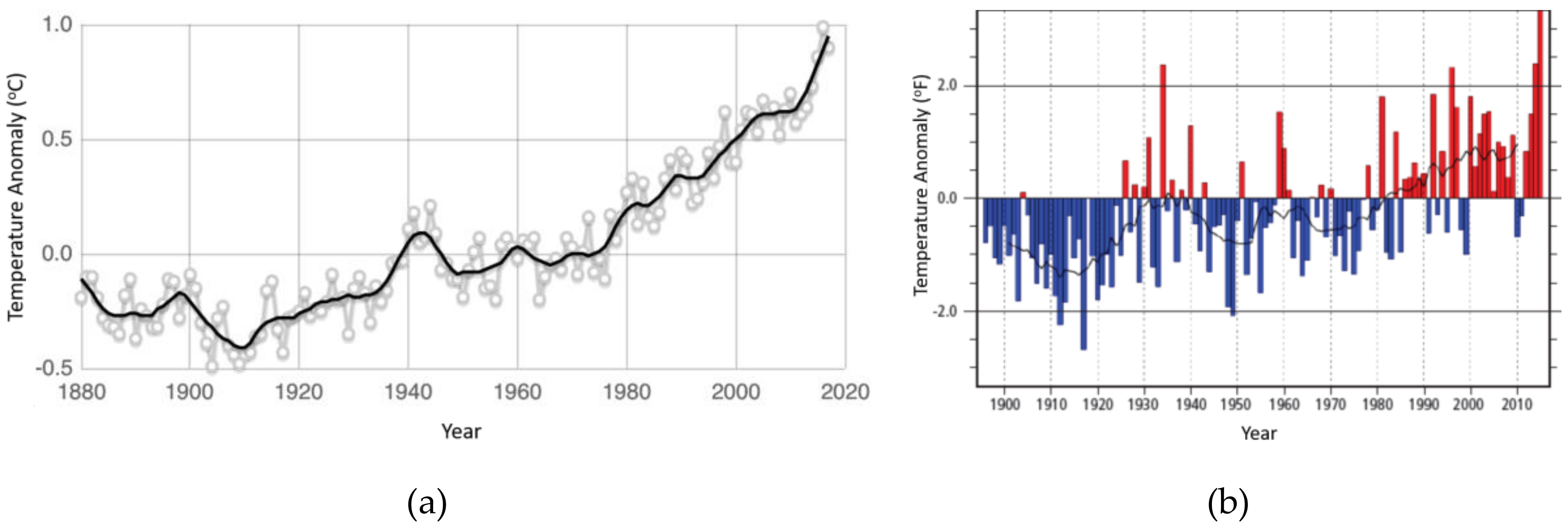
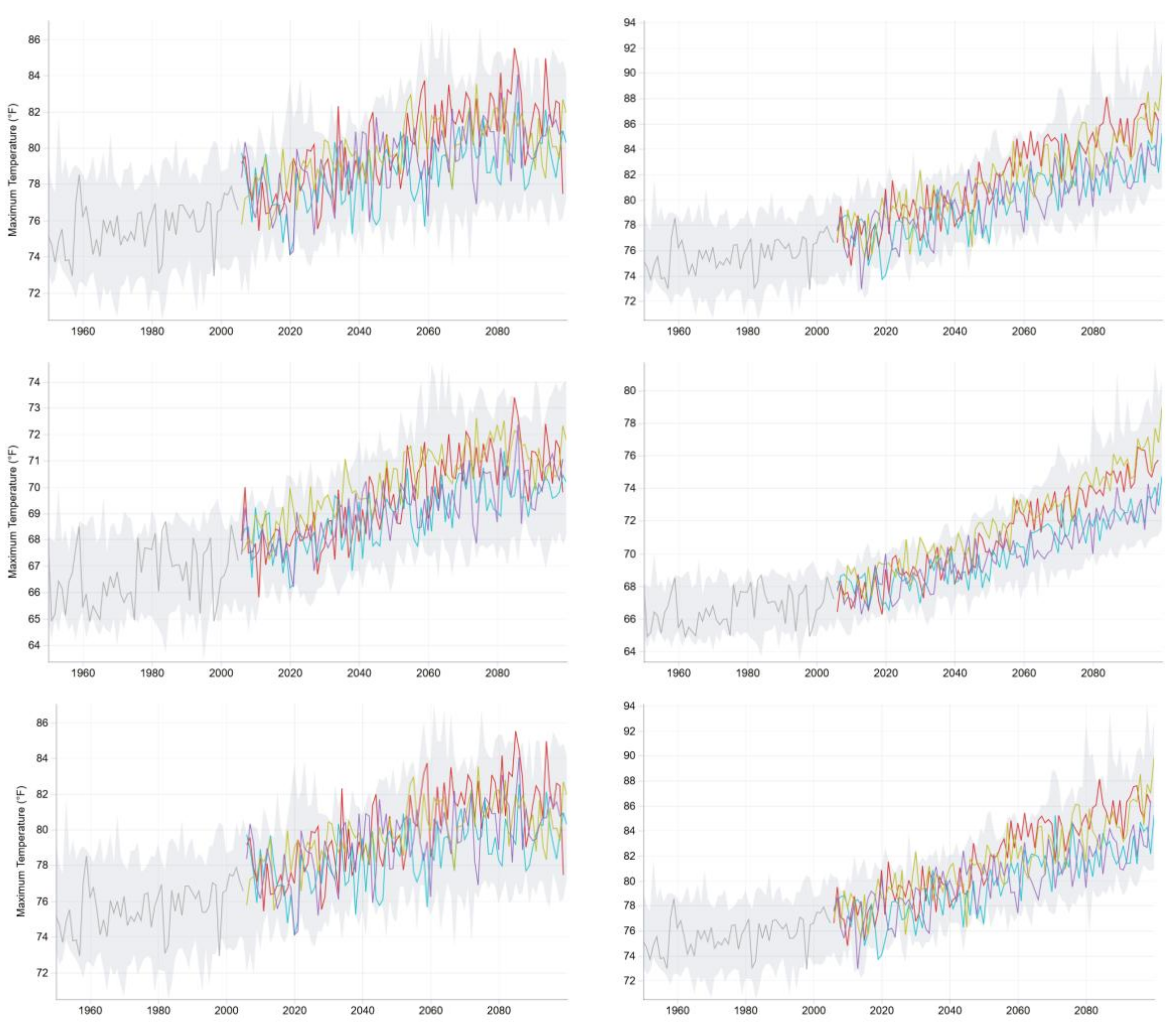
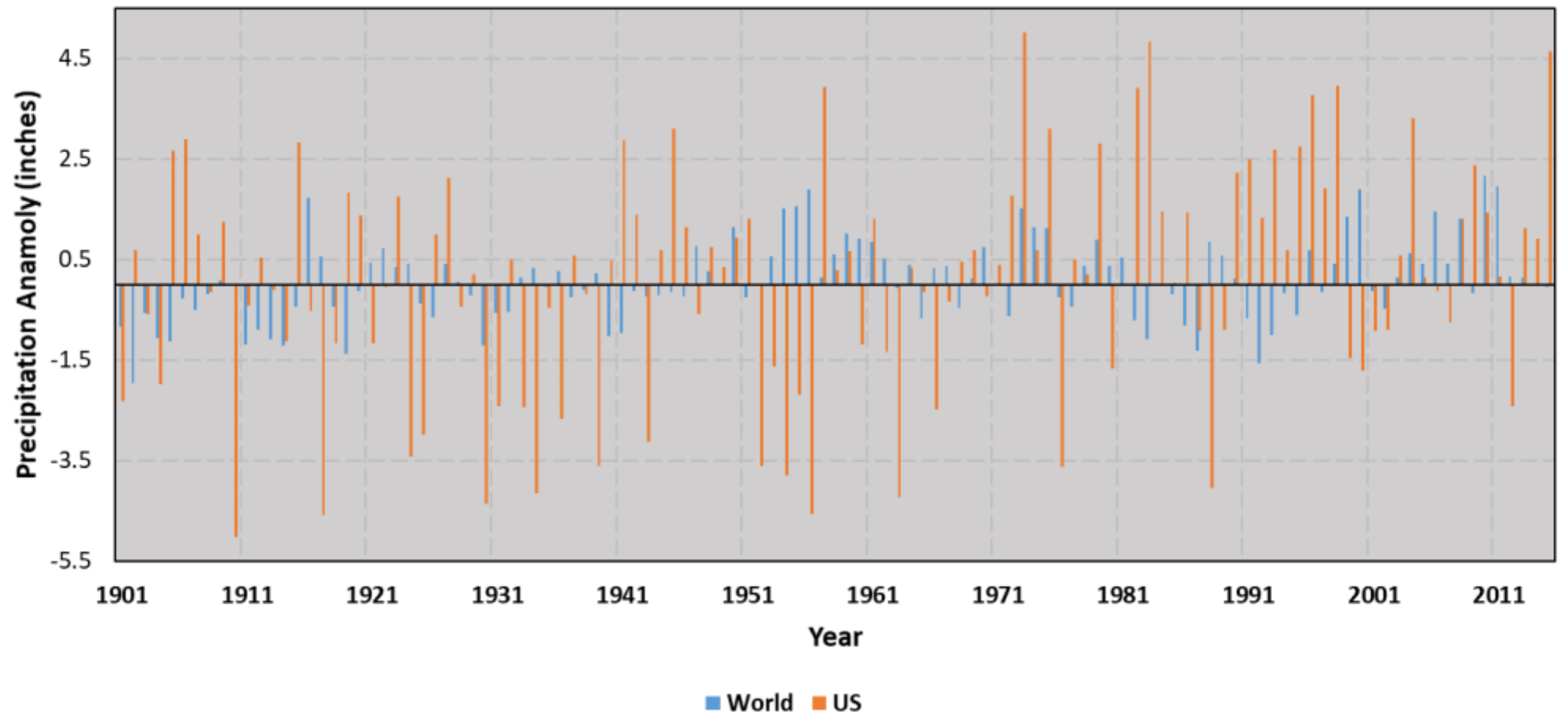
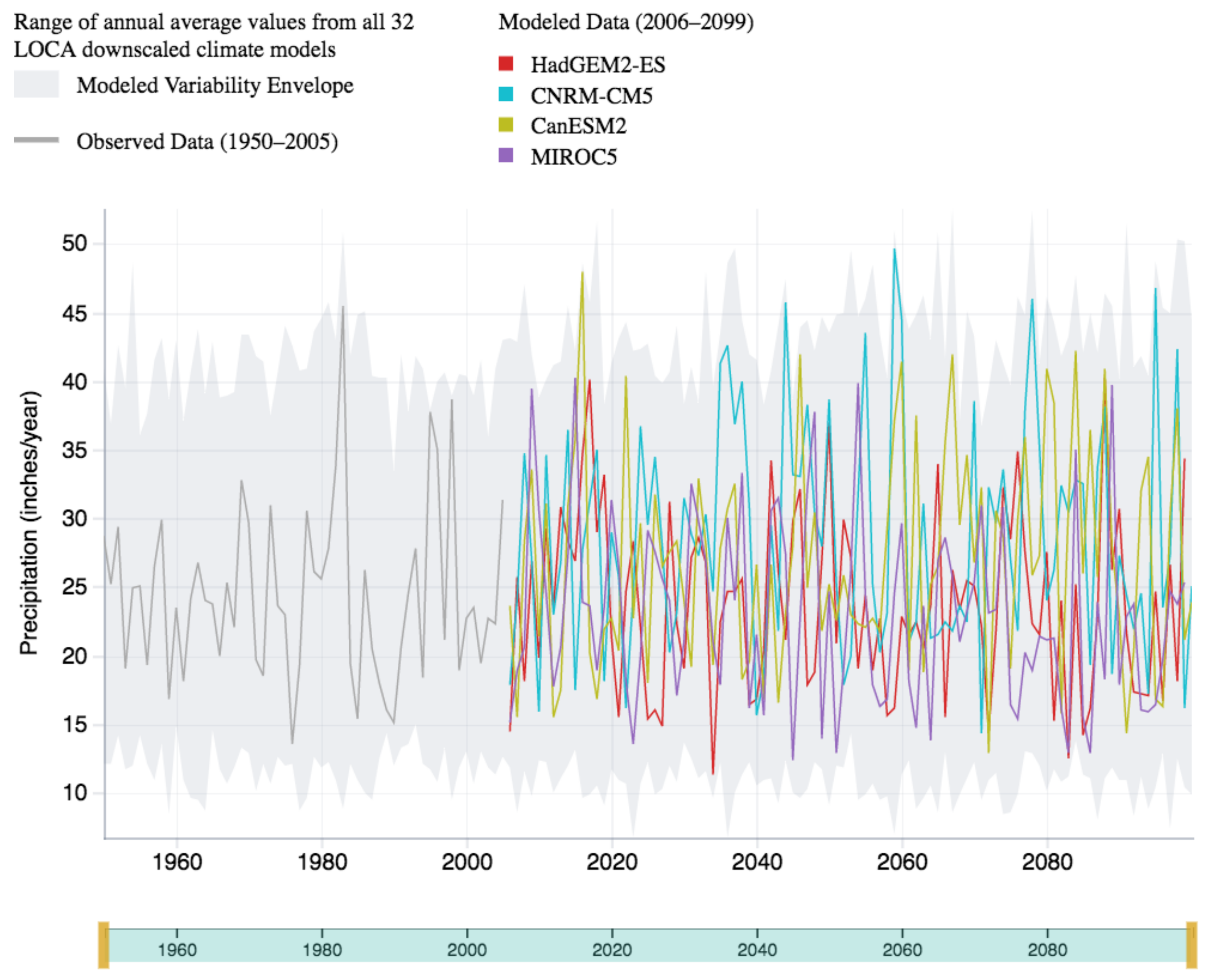
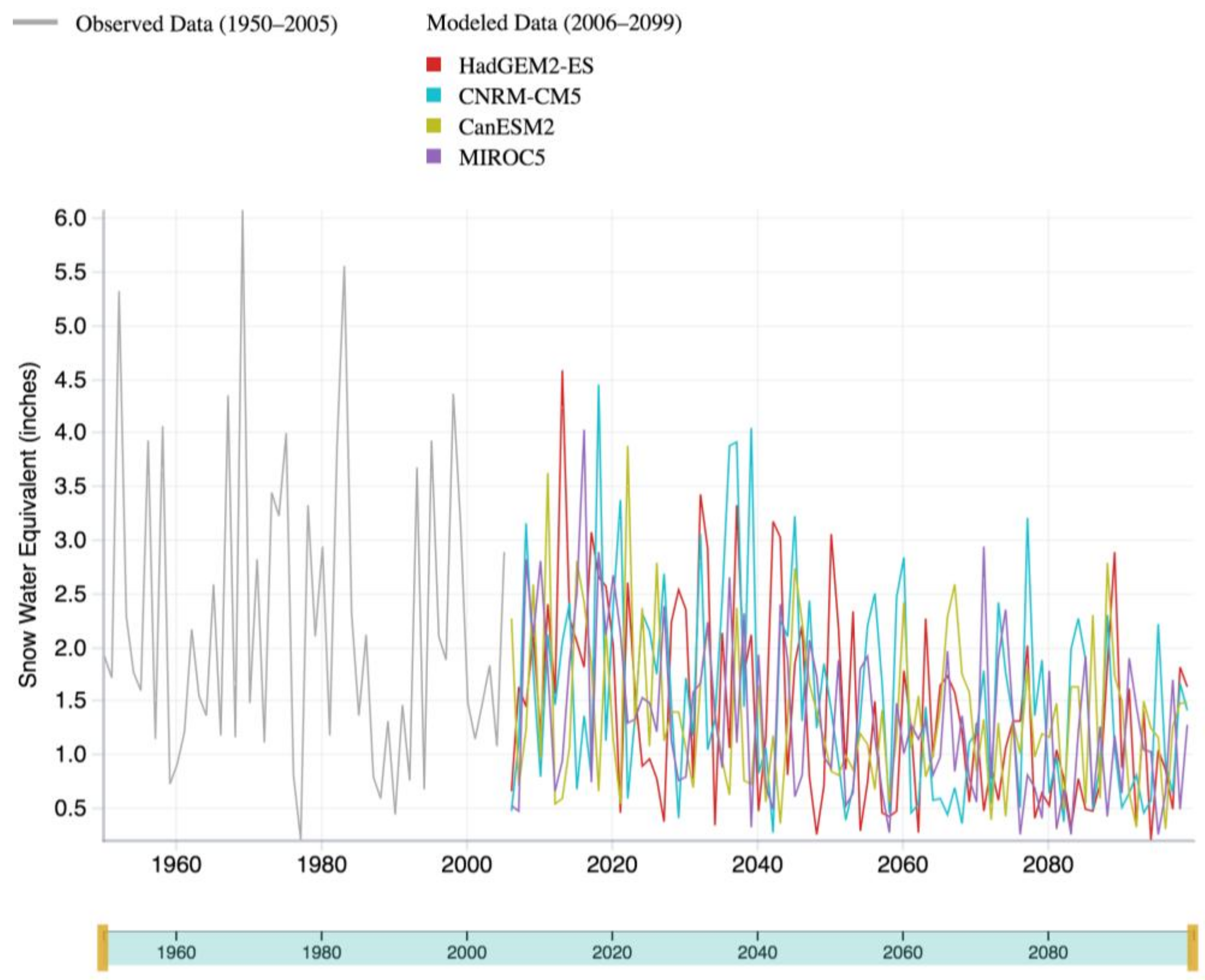
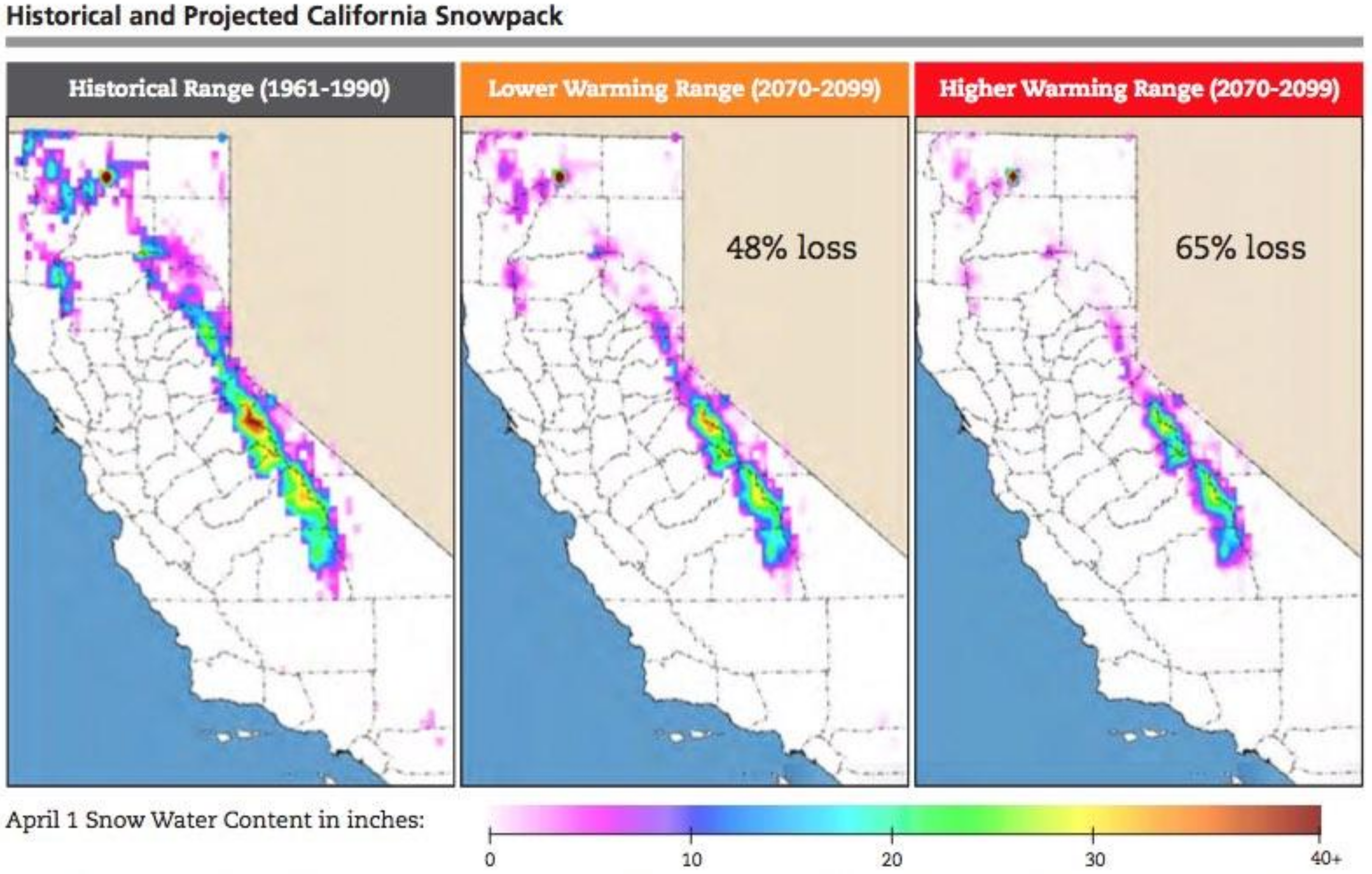
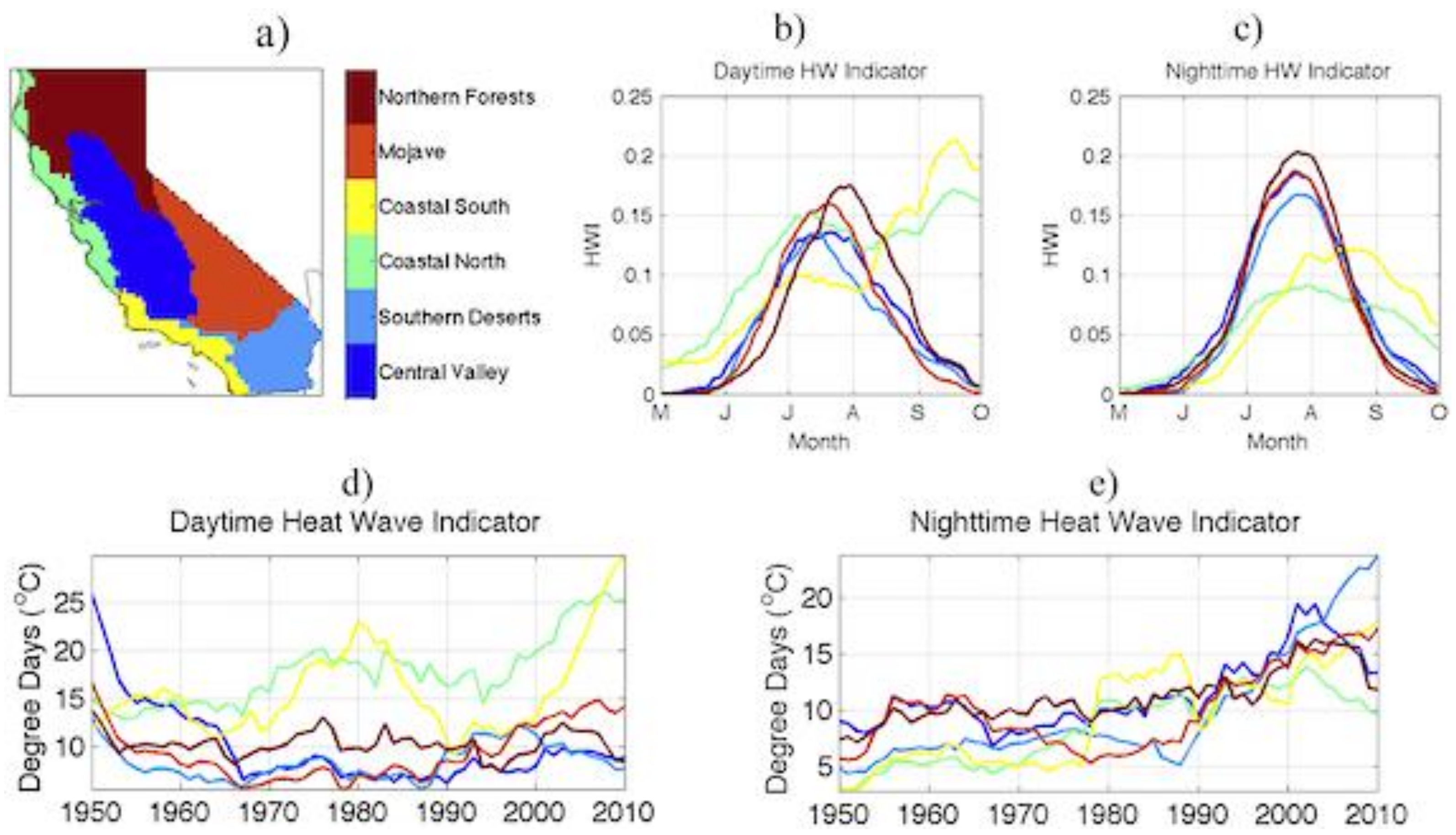
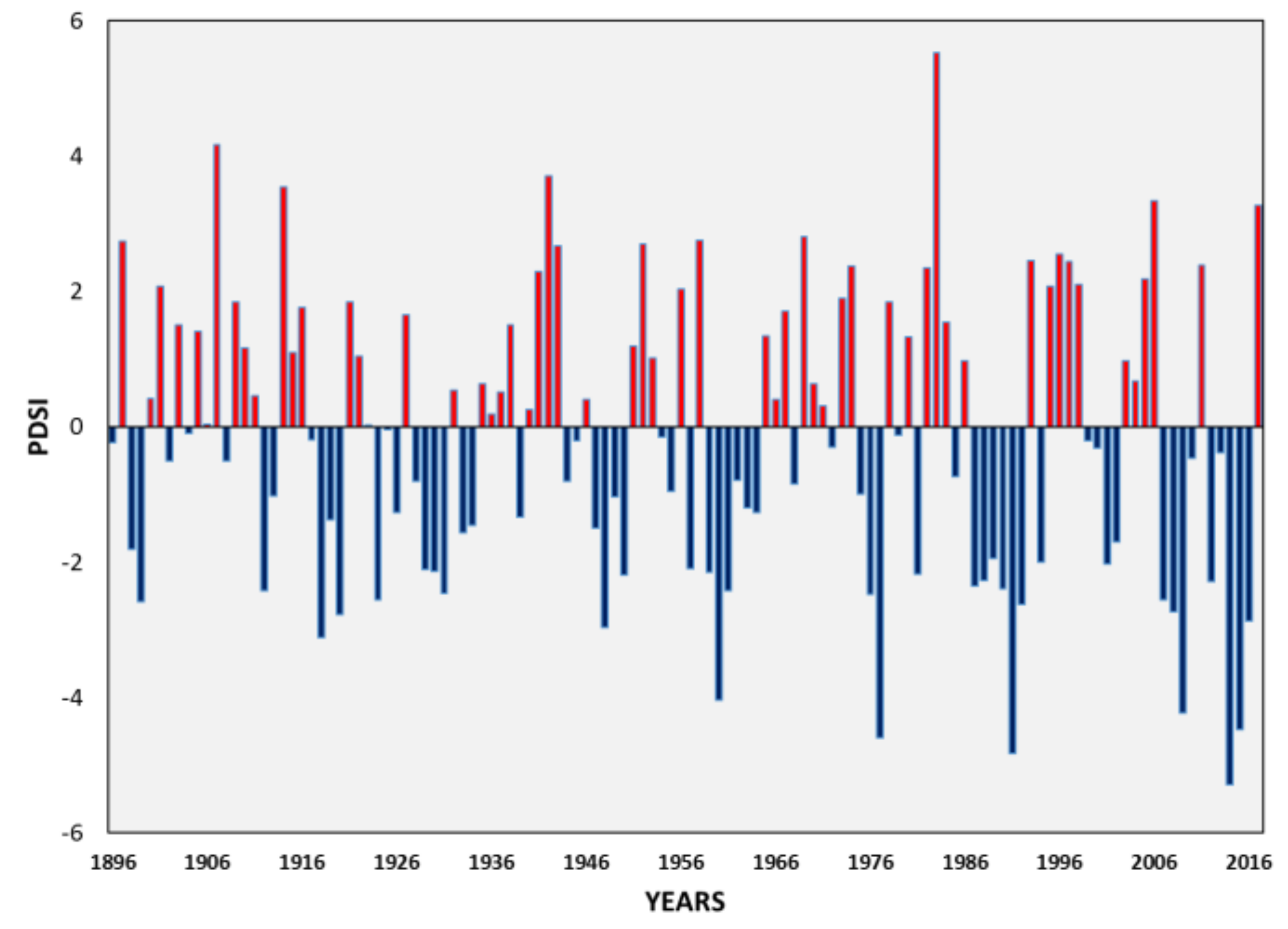
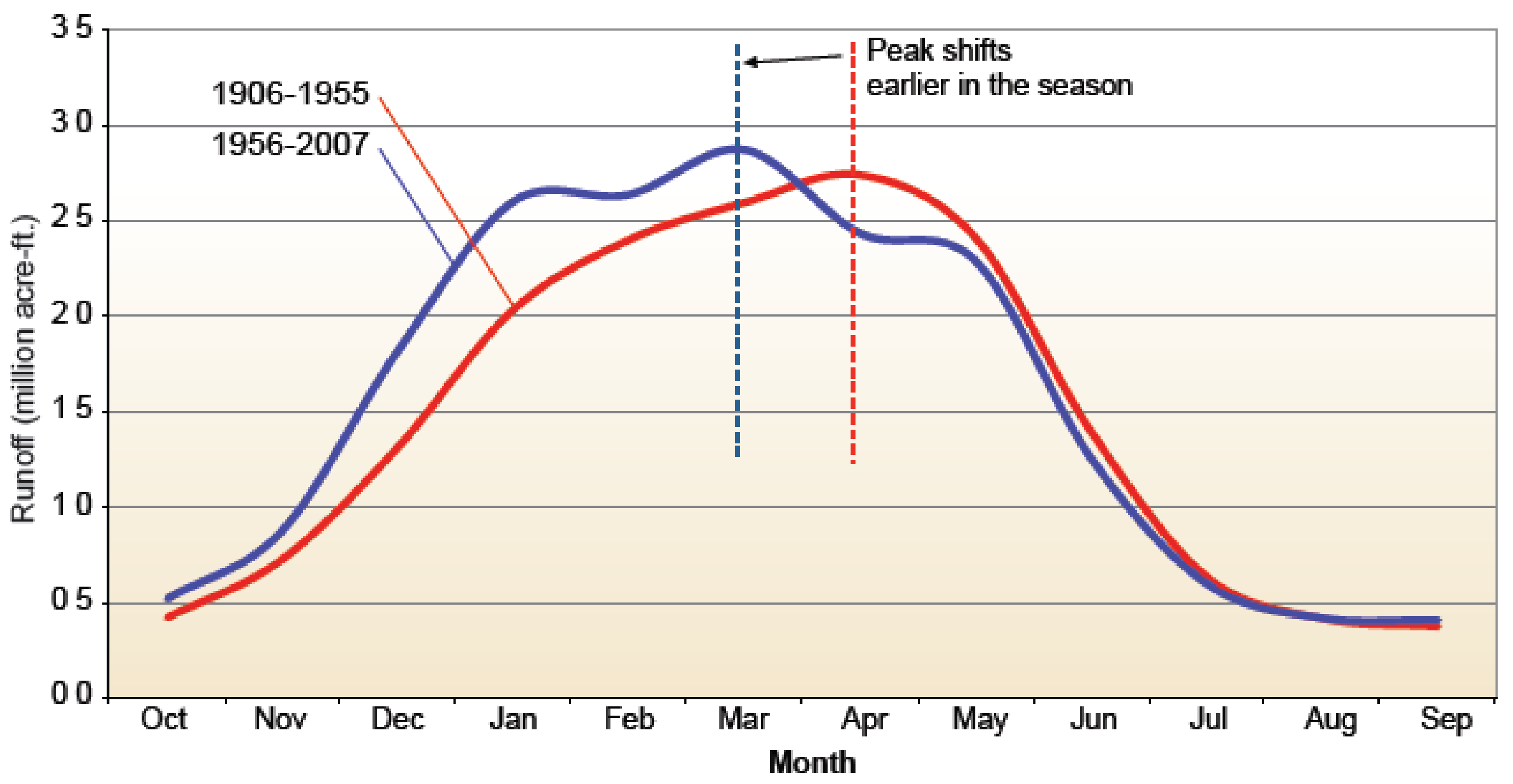
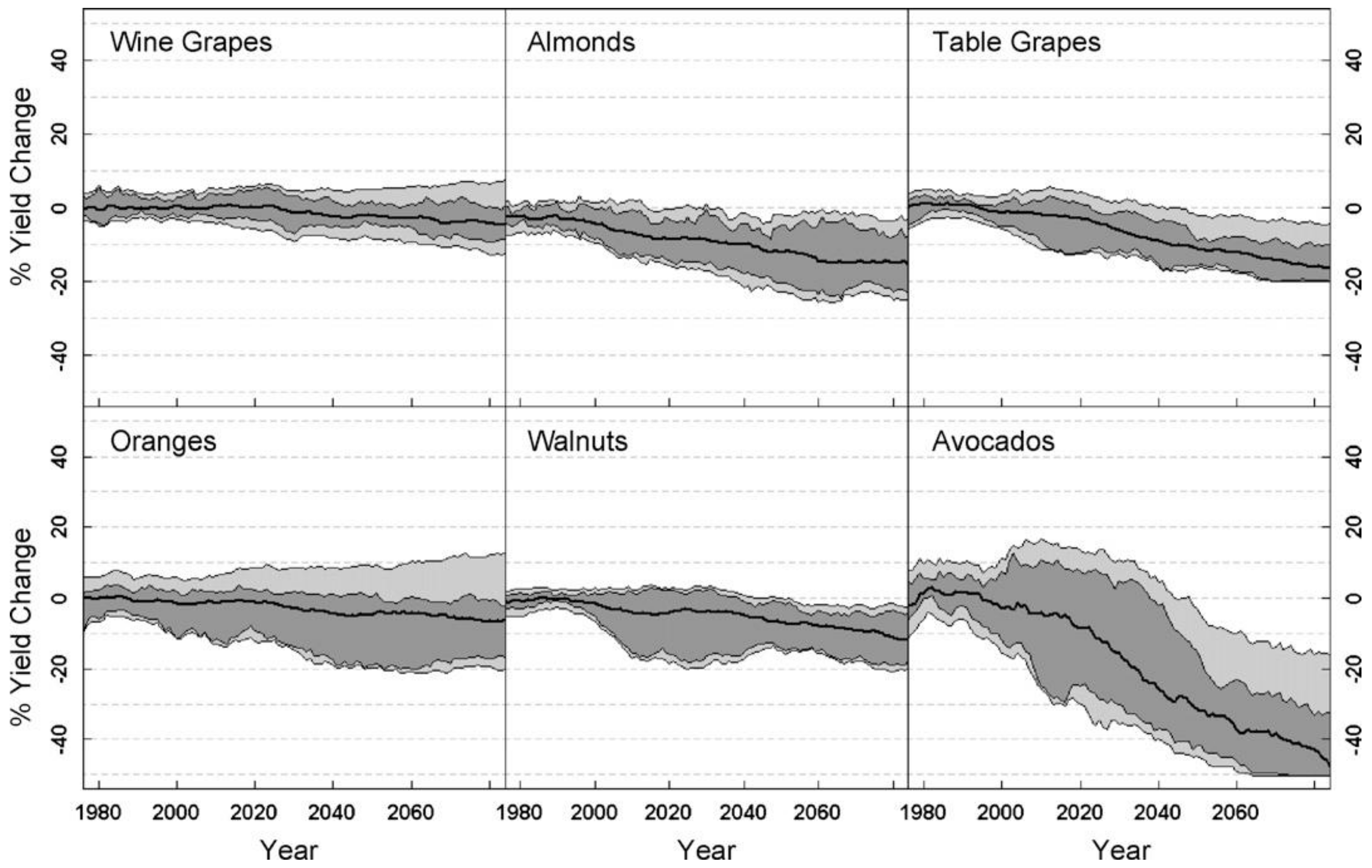
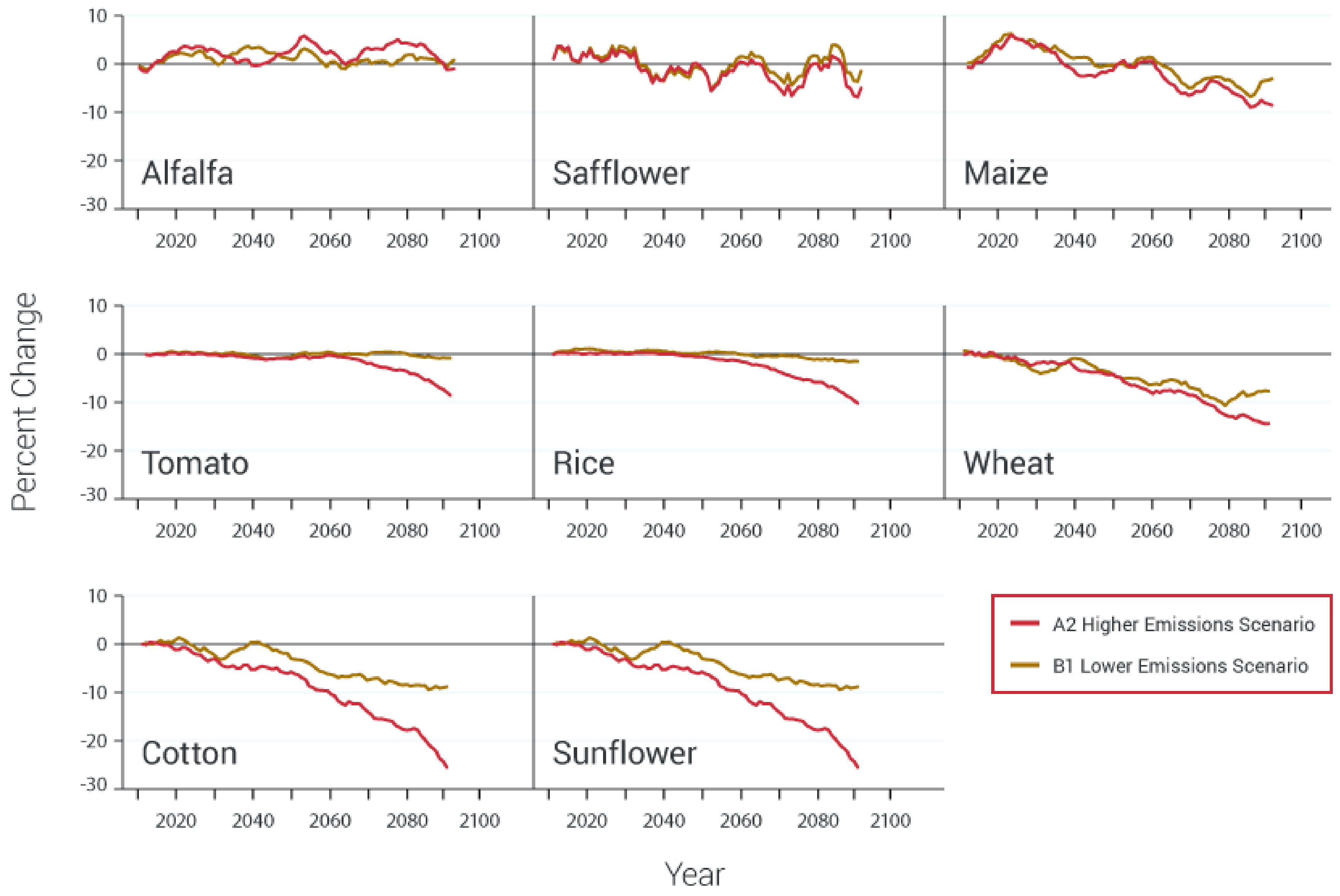
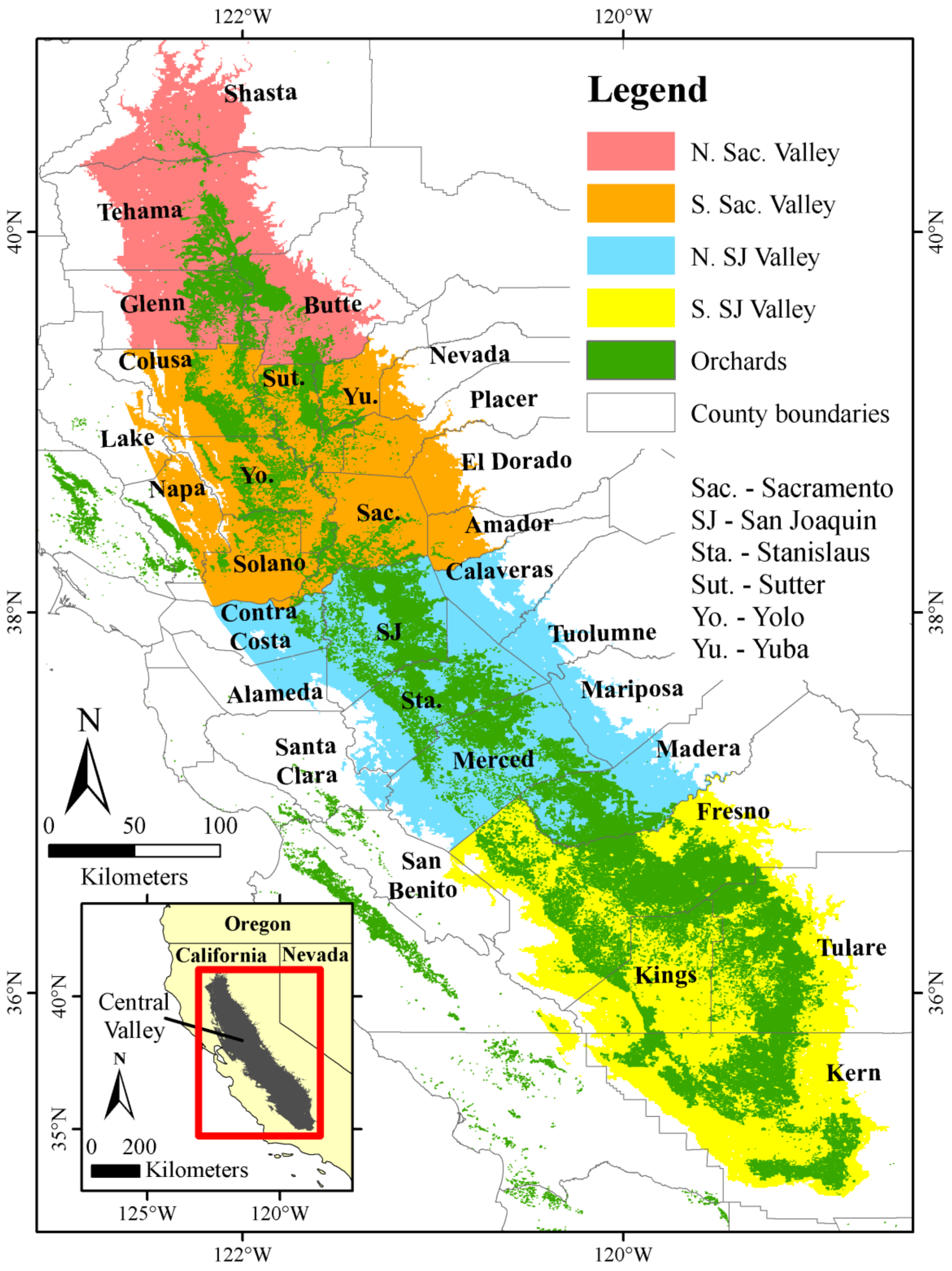
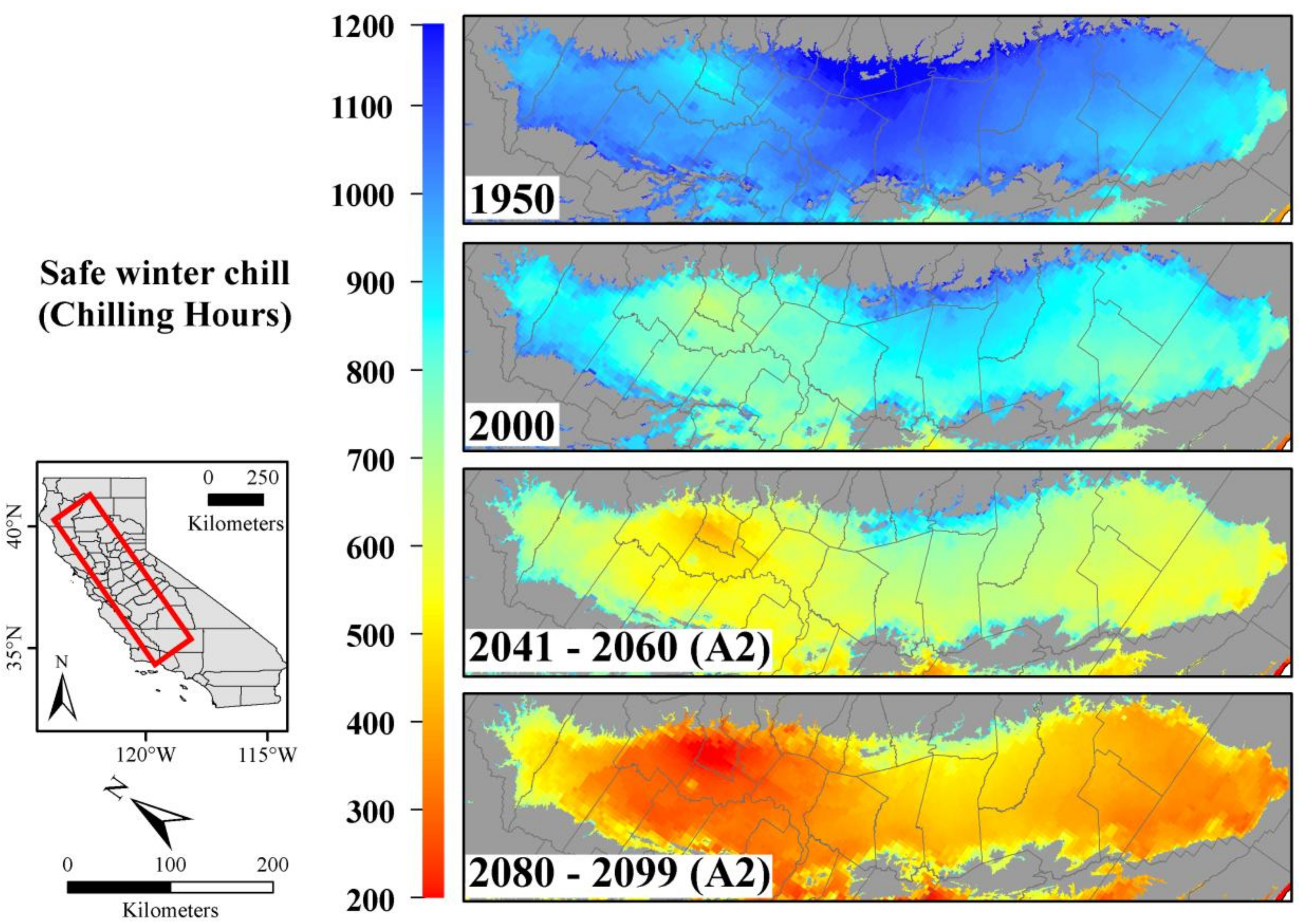
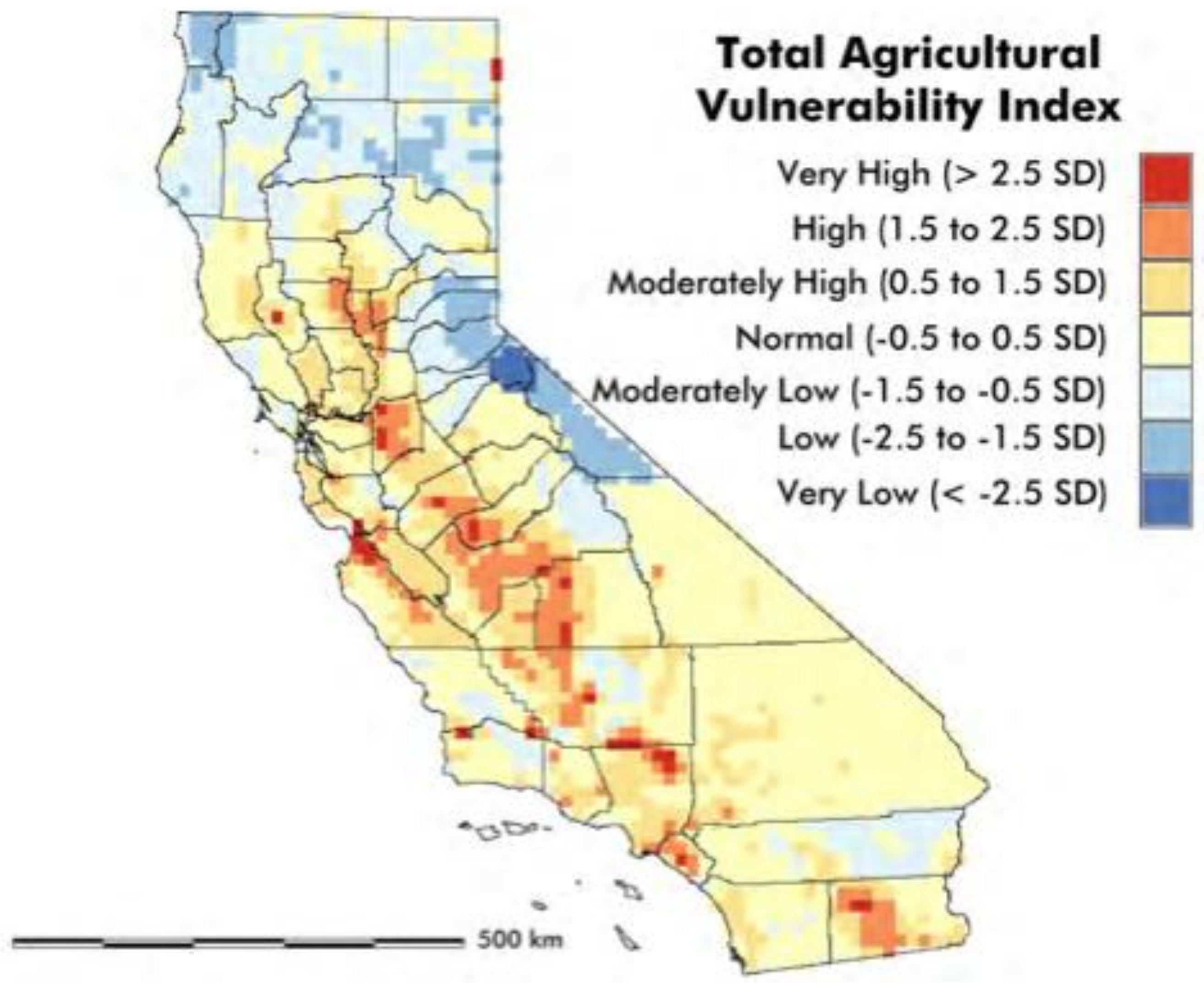
| Linear Trends/100 Years | Annual | Winter | Spring | Summer | Fall |
|---|---|---|---|---|---|
| A. Mean temperature 1895–2011 | +0.87 | +0.66 | +0.95 | +0.94 | +0.85 |
| 1949–2011 | +1.45 | +1.08 | +1.98 | +1.68 | −0.56 |
| 1975–2011 | +2.06 | −0.58 | +2.86 | +3.59 | +1.97 |
| B. Maximum temperature 1895–present | +0.61 | +0.51 | +0.88 | +0.42 | +0.51 |
| 1949–2011 | +0.89 | +0.43 | +1.67 | +1.04 | −0.09 |
| 1975–2011 | +1.77 | −2.17 | +3.20 | +3.31 | +2.19 |
| C. Minimum temperature 1895–present | +1.14 | +0.81 | +1.01 | +1.46 | +1.19 |
| 1949–2011 | +2.01 | +1.73 | +2.31 | +2.32 | +1.22 |
| 1975–2011 | +2.34 | +1.01 | +2.51 | +3.88 | +1.71 |
| Climatic Classification | Crop | Acceptable Temperature for Germination (°C) | Optimal Temperature for Yield (°C) | Acceptable Temperature Growth Range (°C) |
|---|---|---|---|---|
| Hot | Watermelon | 21–35 | 25–27 | 18–35 |
| Melon | 21–32 | |||
| Sweet potato | 21–32 | |||
| Warm | Cucumber | 16–35 | 20–25 | 12–30 (35) |
| Pepper | 16–35 | |||
| Sweet corn | 16–35 | |||
| Snap beans | 16–30 | |||
| Tomato | 16–30 | |||
| Cool-Warm | Onion | 10–30 | 20–25 | 7–30 |
| Garlic | 7–25 | |||
| Turnip | 10–35 | 18–25 | 5–25 | |
| Pea | 10–30 | |||
| Cool | Potato | 7–26 | 16–25 | 5–25 (30) |
| Lettuce | 5–26 | |||
| Cabbage | 10–30 | 16–18 (25) | 5–25 | |
| Broccoli | 10–30 | |||
| Spinach | 4–16 |
| Type of Tree | Approximate Hours | Equivalent Time in Days or Weeks if Continuously Exposed to 7.2 °C/45 °F or Below |
|---|---|---|
| Almond | 200–300 | 8–13 days |
| Apple | 1200–1500 | 7–9 weeks |
| Apricot | 700–1000 | 4–6 weeks |
| Cherry, sour | 1200 | 7 weeks |
| Cherry, sweet | 1100–1300 | 6–8 weeks |
| Chestnut | 300–400 | 2–3 weeks |
| Fig | few hours | --- |
| Filbert (Hazelnut) | 1500 | 9 weeks |
| Kiwifruit | 600–850 | 3.5–5 weeks |
| Olive | 200–300 | 8–13 days |
| Peach/Nectarine | 650–850 | 4–5 weeks |
| Pear | 1200–1500 | 7–9 weeks |
| Pecan | 400–500 | 3–4 weeks |
| Persimmon | <100 | 4 days |
| Pistachio | 1000 | 6 weeks |
| Plum, American | 3600 | 5 months |
| Plum, European | 800–1100 | 5–6 weeks |
| Plum, Japanese | 700–100 | 4–6 weeks |
| Pomegranate | 200–300 | 8–13 days |
| Quince | 300–400 | 2–3 weeks |
| Walnut, Persian (Payne) | 700 | 4 weeks |
| Walnut, Persian (Franquette) | 1500 | 9 weeks |
| Climate Change Trends (Key Findings) | Agricultural Impacts (Key Findings) | Agricultural Adaptation Strategies for Future Research and Implementation |
|---|---|---|
Temperature
|
|
|
Heat Waves
|
|
|
Precipitation and snowpack
|
|
|
Drought
|
|
|
Flood
|
|
|
© 2018 by the authors. Licensee MDPI, Basel, Switzerland. This article is an open access article distributed under the terms and conditions of the Creative Commons Attribution (CC BY) license (http://creativecommons.org/licenses/by/4.0/).
Share and Cite
Pathak, T.B.; Maskey, M.L.; Dahlberg, J.A.; Kearns, F.; Bali, K.M.; Zaccaria, D. Climate Change Trends and Impacts on California Agriculture: A Detailed Review. Agronomy 2018, 8, 25. https://doi.org/10.3390/agronomy8030025
Pathak TB, Maskey ML, Dahlberg JA, Kearns F, Bali KM, Zaccaria D. Climate Change Trends and Impacts on California Agriculture: A Detailed Review. Agronomy. 2018; 8(3):25. https://doi.org/10.3390/agronomy8030025
Chicago/Turabian StylePathak, Tapan B., Mahesh L. Maskey, Jeffery A. Dahlberg, Faith Kearns, Khaled M. Bali, and Daniele Zaccaria. 2018. "Climate Change Trends and Impacts on California Agriculture: A Detailed Review" Agronomy 8, no. 3: 25. https://doi.org/10.3390/agronomy8030025
APA StylePathak, T. B., Maskey, M. L., Dahlberg, J. A., Kearns, F., Bali, K. M., & Zaccaria, D. (2018). Climate Change Trends and Impacts on California Agriculture: A Detailed Review. Agronomy, 8(3), 25. https://doi.org/10.3390/agronomy8030025





